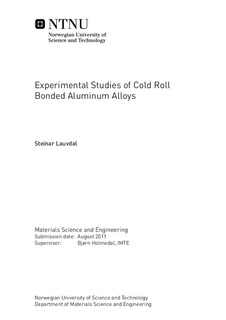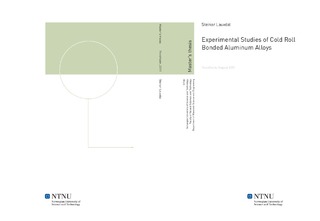| dc.contributor.advisor | Holmedal, Bjørn | nb_NO |
| dc.contributor.author | Lauvdal, Steinar | nb_NO |
| dc.date.accessioned | 2014-12-19T13:26:08Z | |
| dc.date.available | 2014-12-19T13:26:08Z | |
| dc.date.created | 2012-04-20 | nb_NO |
| dc.date.issued | 2011 | nb_NO |
| dc.identifier | 517104 | nb_NO |
| dc.identifier | ntnudaim:6633 | nb_NO |
| dc.identifier.uri | http://hdl.handle.net/11250/249005 | |
| dc.description.abstract | This master s thesis is based on experimental studies of the parameters influencing cold roll bonding (CRB) of the aluminum alloys AA1200 and AA3103,in the work hardened and annealed condition. The effect on the bond strength from the preparations parameters as degreasing agent, scratch brushing and exposure time for oxide growth is investigated in comparison to former studies. Further the effect of rolling speed and effect from contributing factors from the different testing methods is discussed. Three different methods for testing the bond strength are used. One of them was established during this study and was named Tensile Bond Strength Test (TBST). A final investigation of the fracture surfaces and bond interface in a scanning electron microscope (SEM) was carried out to analyze the bond mechanism and distribution of fractured oxides.The TBST is testing the direct bond strength with no peel or shear forces involved. It also only requires a fraction of the sample material for testing and any roll bonded sample is applicable for this test. These are the huge advantages with the test method. The test method is however still naive, and suffers from a series of challenges. The current test ranged is from 4MPa to 40MPa, but with potential for a large range expansion. Further are bond damaging effects, caused by the machining, reducing the accuracy of the measurements and compromising grooving ; a measure taken for increasing the test range above 40MPa.The strain rate at which the samples were tested, showed to have strong influence on the measured bond strength. Much higher than the effect of any work hardening on either of the alloys. The preparation prior to roll bonding including an only 90s exposure time to air, ensures a very thin oxide layer and bonding at reductions down at 22.3%. Ductile stretch lips was found on the fracture surface, and run in direction normal to the rolling direction. The fraction of bonded surface area did not seem to follow the percent of reduction during roll bonding, which indicates a thinning of the oxide layer. | nb_NO |
| dc.language | eng | nb_NO |
| dc.publisher | Institutt for materialteknologi | nb_NO |
| dc.subject | ntnudaim:6633 | no_NO |
| dc.subject | MTMT Materialteknologi | no_NO |
| dc.subject | Materialutvikling og -bruk | no_NO |
| dc.title | Experimental Studies of Cold Roll Bonded Aluminum Alloys | nb_NO |
| dc.type | Master thesis | nb_NO |
| dc.source.pagenumber | 114 | nb_NO |
| dc.contributor.department | Norges teknisk-naturvitenskapelige universitet, Fakultet for naturvitenskap og teknologi, Institutt for materialteknologi | nb_NO |

